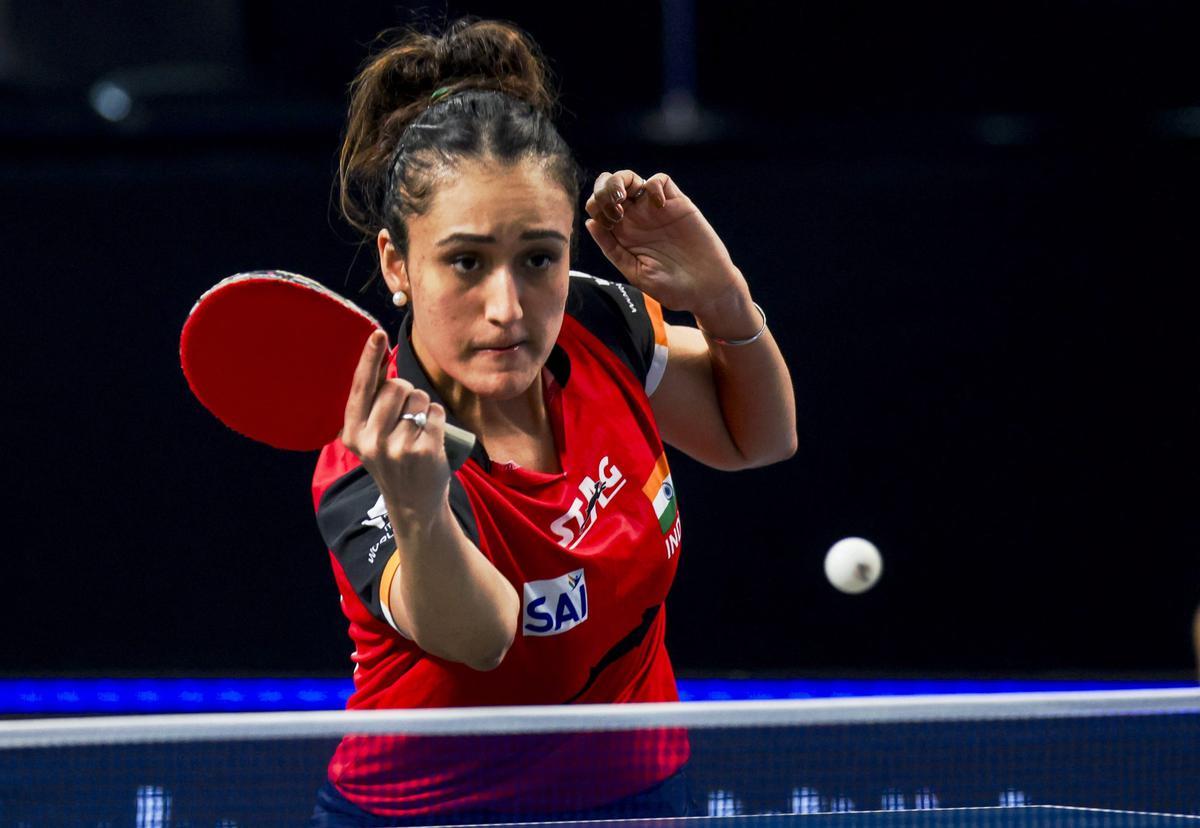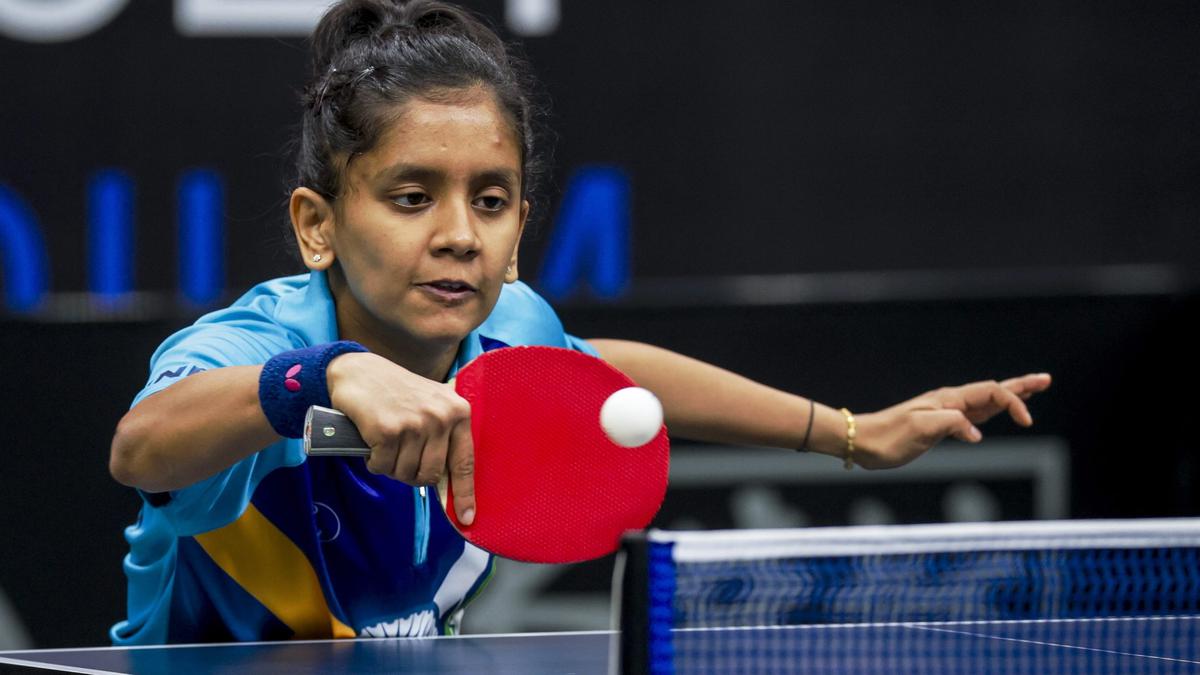Challenging road ahead but paddlers show promise at the WTT Star Contender
At the WTT Star Contender in Goa, there was a moment in Sreeja Akula’s quarterfinal against Cheng I-ching when she would have felt she was a couple of points away from wresting the initiative from her Taiwanese opponent.
After dropping the first game, Sreeja stormed back to claim the second at the Peddem Indoor Stadium in Mapusa. Receiving serve at 5-7 in the third, Sreeja pushed the pace in the rally, twiddling the bat in her hand and making a firm backhand drive. It was a trick that had worked well for the 25-year-old Indian in the second game. But this time Cheng read the return well, countering with a sharp top-spinning backhand that reversed all the pressure back on Sreeja.
She defended Cheng’s shot, but it was only enough to set up a giant forehand that she was unable to counter. And, just like that, the moment was lost. Cheng won this game and the next to claim the tie 3-1, and in doing so brought India’s campaign to an end.
Sreeja, who isn’t a player who visibly shows disappointment, gamely shook hands with her opponent. All in all, it was a result that shouldn’t have come as a surprise. For, she had only reached a career-high world ranking of 66 at the start of the week following her judicious decision to compete at the WTT Contender in Corpus Christi. Meanwhile Cheng was an Olympic bronze medallist from Tokyo (albeit in mixed doubles) and a former top 10 in singles, who went on to win the title in Goa.
No Indian women’s singles player has ever gone higher in a WTT Star contender event than Sreeja, who beat two higher ranked players in her run to the quarterfinals — world no. 30, Hana Goda of Egypt, in the round of 32, and world no. 33, Hoi Kem Doo of Hong Kong, in the pre-quarters.
ALSO READ | Shaker of stereotypes: Hugo Calderano, Brazil’s vegetarian table tennis phenom
Given her recent form, particularly her success in Goa, Sreeja’s days as an underdog may soon end. Just a week after her impressive performance in Goa, she climbed to a career-best 51st in the global rankings.
However, she wasn’t the only Indian women’s singles player who got a bump in rankings. Manika Batra, the No. 1 women’s singles table tennis player in India, also rose two places to 36th following her progress to the pre-quarters in Goa, beating world no. 53, Suh Hyo-won of South Korea, along the way.
Archana Kamath also surged 22 places to 112th in the world rankings after beating world no. 52 Jieni Shao and world no. 62 Maria Xiao to reach the last 16.
While India has had strong results at the WTT Contender before — Batra for instance reached the last 16 in Goa last year too — the clutch of performances in the 2024 edition is unprecedented. “It’s a sign of the bench strength of Indian table tennis right now,” Batra said, after making it to the pre-quarters.
Indeed, the Indian women’s performances shone brighter than that of the Indian men, of whom just one — Snehit Suravajjula — won a match in the main draw, beating a fellow Indian in the round of 64.
While there’s something to be said about the tournament featuring a depleted field compared to the 2023 edition (neither China nor Japan sent teams as they focussed on Olympic preparation), there’s no denying the fact that India pulled off a surprising set of upsets in women’s singles at least.

Cornerstone: As the all-important World Team Championships looms around the corner, India will hope an ever-reliable Manika Batra instils a renewed sense of belief in the rest of the team.
| Photo Credit:
PTI
Cornerstone: As the all-important World Team Championships looms around the corner, India will hope an ever-reliable Manika Batra instils a renewed sense of belief in the rest of the team.
| Photo Credit:
PTI
These results are important in more ways than one. It’s also a major shot in the arm for Indian table tennis ahead of the all-important World Table Tennis Team Championships, which is the penultimate chance to secure a spot for the women’s team in the Olympic Games, with the final slot given to the highest ranked team. It’s a feat that’s yet to be accomplished in Indian table tennis history.
India needs to finish inside the top eight of the World Championships for this to happen. India has come close in the past. At the 2020 Olympic team qualifiers, the Indian women’s team was just a singles win away from booking their tickets to Tokyo. Unfortunately, Manika Batra was upset by Daniela Dodean Monteiro as India lost 3-2 in the round of 16 stage.
While Batra reprises her role as the talisman of the team heading to Busan, she will be joined by the likes of Archana, Sreeja, Ayhika and Diya Chitale, who will be brimming with confidence this time around.
The results at Peddem would have come as a particular boost to Archana who had a torrid last couple of seasons, compounded by a dispute with the national federation. She has since found a new sense of vigour after shifting her training base from Bangalore to Noida in recent months.
Indeed the likes of Sreeja will be backing themselves to get even better. In her quarterfinal match against Cheng, the 25-year-old year old put on display a new technique that she has been working on — twiddling. It’s a technique that involves the player flipping the table tennis bat in their hand to change the rubber facing the ball. But it isn’t something new. Batra first used it to great effect en route to her gold medal at the 2018 Commonwealth Games.
Both Manika and Sreeja use smooth ‘spinny’ rubber on one side and long-pimpled rubber on the other. Normally this means that the long-pimpled side (conventionally the backhand side for the Indians) is used to dampen the spin while the smooth (forehand side) imparts it. If she doesn’t twiddle, Sreeja can become very predictable.
“If I play only with the pimpled side instead of changing the pace of the ball (by flipping the playing side of the bat) then it’s not easy for me to beat the top players,” she says, while explaining the need to use the technique. But when she twiddles, this means she can now play with long pips and smooth rubbers from both forehand and backhand. which, although challenging to pull off, will keep her opponents off balance trying to adjust to various types of balls coming from both sides.
While Manika is adept in the technique, Sreeja is still perfecting the skill. But as her match against Cheng showed, she’s gaining confidence steadily. “I’ve been practising this for some time but I’ve not had a lot of confidence while trying it in a match. This time I used it a lot against Cheng. I know I missed a lot of balls because I was trying out something new; I’ve never done it so much as I did today. But I’m happy that I was bold enough to do it,” she said.
It’s not just her twiddling that could create some doubt in the minds of opponents at Busan. “My forehand attack has improved a lot. It’s become very powerful. I am also moving really quick. So that’s also a positive,” she says. As the all-important World Team Championships looms around the corner, India will hope an ever-reliable Batra instills a renewed sense of belief in the rest of the team. The results in Goa have gone a long way towards that. It allows the team to focus on putting all their efforts towards that tournament rather than having to think about the singles qualifying tournament they might have to play should they fail to make the cut as a team.
“Because of the increase in our rankings, our seeding will improve not just for the World Team Championships but also for the singles qualifier afterwards (in May). It also gives us a chance to go through (in the final shot at qualifying) based on ranking.
“Because of this we don’t have to play any more WTT tournaments. We of course have to play the World Championships and the singles qualifying tournaments, but apart from that we can now focus on our training completely,” Sreeja says.



